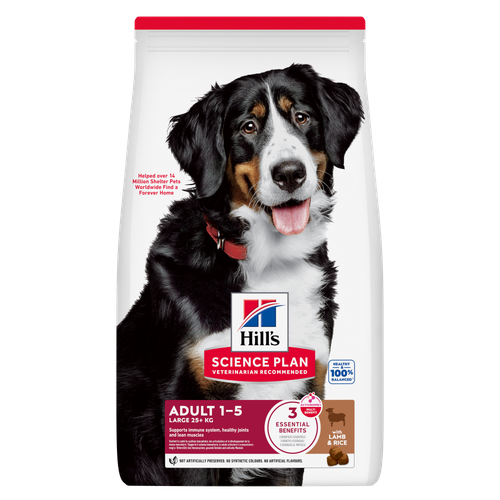
-
Find the right food for your petTake this quiz to see which food may be the best for your furry friend.Find the right food for your petTake this quiz to see which food may be the best for your furry friend.Featured products
 Small & Mini Mature Adult 7+ Dog Food
Small & Mini Mature Adult 7+ Dog FoodHill's Science Plan Small & Mini Breed Mature Adult Dog Food with Chicken is a complete pet food, specially formulated with ActivBiome+ Multi-Benefit Technology.
Tailored nutrition to support graceful ageing in small dogs. Specially made with a synergistic blend of nutrients for energy & vigor.Shop Now Perfect Digestion Large Breed Puppy Food
Perfect Digestion Large Breed Puppy FoodPrecisely balanced nutrition with Hill's ActivBiome+ prebiotic blend actively contributes to supporting digestive health and overall well-being to help your pet feel their best
Shop Now Perfect Digestion Small & Mini Adult Dog Food
Perfect Digestion Small & Mini Adult Dog FoodHill's Science Plan Perfect Digestion Small & Mini Breed Adult Dog Food with Chicken & Brown Rice supports ultimate digestive well-being & a healthy microbiome.
Shop NowFeatured products Kitten Food
Kitten FoodTender chicken chunks in gravy for kittens, with omega-3s for healthy eye & brain development and high-quality protein to support muscle growth. With balanced minerals to promote strong bones & teeth.
Shop Now Hypoallergenic Dry Cat Food
Hypoallergenic Dry Cat FoodHILL'S SCIENCE PLAN Hypoallergenic Adult cat food with egg & insect protein is a complete pet food for adult cat 1–6 years old. It's formulated for cats with delicate skin and stomach, with limited high quality novel protein sources & no grain.
Shop Now Hairball & Perfect Coat Adult Cat Food
Hairball & Perfect Coat Adult Cat FoodHill's Science Plan HAIRBALL & PERFECT COAT Adult cat food with Chicken is specially formulated to effectively help avoid hairball formation in adult cats while promoting a beautiful coat. Thanks to its mix of essential Omega-6 fatty acids, this food benefits the cat's skin and fur keeping them healthy and shiny. Our Advanced Fibre Technology helps reduce hairballs by naturally promoting their passage through the gut. This food is formulated with high-quality protein for a perfectly balanced, great-tasting recipe.
Shop Now -
Dog
- Dog Tips & Articles
-
Health Category
- Weight
- Food & Environmental Sensitivities
- Urinary
- Digestive
- Joint
- Kidney
-
Life Stage
- Puppy Nutrition
- Adult Nutrition
- Senior Nutrition
Cat- Cat Tips & Articles
-
Health Category
- Weight
- Skin & Food Sensitivities
- Urinary
- Digestive
- Kidney
-
Life Stage
- Kitten Nutrition
- Adult Nutrition
Featured articles The Right Diet For Your Pet
The Right Diet For Your PetLearn what to look for in healthy pet food & nutrition, including ingredients, quality of the manufacturer, your pet's age, and any special needs they have
Read More Pet Food Storage Tips
Pet Food Storage TipsWhere you store your cat and dog food can make a big difference in the quality and freshness once it is opened. Here are some common questions and recommendations for optimal storage for all of Hill’s dry and canned cat and dog food.
Read More Understanding Your Pet's Microbiome
Understanding Your Pet's MicrobiomeLearn what a pet's microbiome is, how it contributes to your pet's gut & overall health, and why nutrition is important in maintaining healthy microbiomes.
Read More -


Bringing home a new dog is a big adjustment. Hopefully, your wriggly new addition is content as can be, surrounded by the non-stop love and attention of their new family.
But, as Monday morning approaches, anxiety creeps in. Jobs and school could force you to leave your new dog at home for a few hours (unless you're among the fortunate few that get to bring your dog to work with you). So, how can you make sure your dog stays safe and happy while you're away?
Crate Train Your Dog
A crate, if used correctly, is an excellent tool for housetraining a dog, but it can also be your dog’s go-to spot when they’re home alone — a haven and a place for a nice nap. While a crate might be a good option for part of a 9-to-5 workday, you want to be careful not to overdo it. Consider that if your dog has been in the crate all night, you shouldn’t be leaving them cooped up all day too. Crates can be a valuable tool, but if you find that your dog avoids spending time in their crate when the door is open, or no longer enters the crate willingly, you must reconsider how and why you are using it.
Get a ‘Doggy Cam’
Indoor cameras that you can monitor via your phone, are excellent tools to check up on your dog if you are worried about them being home alone. There are many options available on the market that allow you to both see and hear your dog and can alert you to activity or noise so that you can do a quick check in.
Designate a Dog-Proof Room
If you have to leave your dog home all day, think about dog-proofing a small room in your home that can be closed off from the rest of the house. Blue Cross lists several points that pet parents should address when dog-proofing a room:
- Unplug electrical items and hide wires and cables.
- Remove hazardous chemicals, like cleaning products and medications.
- Keep food out of reach.
- Keep chairs and other furniture away from tables or worktops to prevent climbing.
Basically, get rid of absolutely everything your dog could get into while you're gone, and remove any objects that could be chewed or swallowed, such as shoes or coins.
A good room to choose might be one with an easy-to-clean floor, such as tile. Set up designated spaces for sleeping and play. Leave water and toys so they don’t get bored, and put out newspapers or puppy pads on the floor in case of accidents. If your new dog is a puppy, accidents are bound to happen.
Getting Your New Dog Used to Being Alone
Leave them alone in the room for a few minutes at a time until they get used to the idea, then slowly increase the amount of time they’re alone. As your dog starts to adapt to this room, and you feel comfortable with their behaviour, you can start to expand their access to more of the home when you're away. Good tests for this are when you're only going to be away for 30 to 60 minutes or so, like a trip to the supermarket. If they can behave in a larger area for a short time, you can also gradually lengthen the time they’re allowed to roam in the house while you're away until you reach a full workday.


Tasty Tips
Provide Sufficient Enrichment
Ensure that you provide plenty of things to keep your new pooch happy and occupied. - appropriate food dispensing toys and chew toys can keep your dog occupied for some of the time that they are awake while you are away. Make sure anything you leave with your dog is safe to do so and that you have supervised them the first few times so you know they won’t destroy and swallow pieces of them.

Hire a Dog Walker
A walk during the day is more than just good exercise for your dog. A good walk can also stimulate them by engaging all their senses, help socialise them with other animals and humans, and speed up the house-training process. In addition, a good walk will tire your dog, which may make them less likely to chew or engage in other destructive behaviours while they wait for you to return home. If you have children home for the summer and they’re old enough to walk the dog, this is a great way to help strengthen their bond with your dog. It’s also a good way to get them out of the house for some exercise of their own.
Enrol Your Pooch in Doggy Daycare
A quality doggy daycare offers a much-needed outlet for dogs. They usually let dogs roam free in play, offer activities and games, and have staff members who can give plenty of love and attention to your dog. A daycare can also be a good option for families with hectic lives, seniors, or anyone else who doesn't have the time or ability to give their dog the exercise or time they require.
Blue Cross recommends considering the following when choosing a doggy daycare:
- Do they have professional training in dog behaviour, first aid, and other important aspects of dog care?
- Are they properly licensed and insured?
- Where will your dog play, exercise and rest?
- How many other dogs will be there and by how many people will they be supervised?
- Are they equipped to take care of any special needs your dog may have due to age, health, etc.?
Make sure to read reviews or ask friends and family about quality daycare places, and make sure to do a tour of the facility before leaving your dog. The nice part of a doggy daycare is that you don't have to take your dog every day, which can sometimes get expensive. A day or two at the daycare will help get your dog exercise as well as socialise them with other dogs.
Take Some Time Off
"Pawternity" leave is a new concept that's taking off in the UK, reports The Independent. Talk to your boss about whether they might be open to you taking a few days off, working from home, or stepping out for an extra half an hour at lunch so you can run home to take your dog for a midday walk. Adopting a new puppy (or any dog for that matter) is a big responsibility. You should only do so when you know you and your family will have time to devote to them, their training and development.
Bringing home a new pet takes lots of time, love and devotion, and it's impossible to explain to your furry bundle of joy that you have to go to work. But by thinking through your options and having a plan in place, you can avoid the stress and guilt you feel when you have to leave your dog alone. And if it's any consolation, it makes the time you do get to spend together all that more special.


Kara Murphy is a freelance writer and pet parent who lives in Erie, Pa. She has a goldendoodle named Maddie.
Related products

Hill's Science Plan Large Breed Adult Dog Food with Lamb & Rice is a complete pet food, specially formulated with ActivBiome+ Multi-Benefit Technology.
This food is specifically designed to fuel the energy needs of large breed dogs during the prime of their life.

Hill's Science Plan Perfect Digestion Small & Mini Breed Adult Dog Food with Chicken & Brown Rice supports ultimate digestive well-being & a healthy microbiome.

Precisely balanced nutrition with Hill's ActivBiome+ prebiotic blend actively contributes to supporting digestive health and overall well-being to help your pet feel their best

Hill's Science Plan Small & Mini Breed Mature Adult Dog Food with Chicken is a complete pet food, specially formulated with ActivBiome+ Multi-Benefit Technology.
Tailored nutrition to support graceful ageing in small dogs. Specially made with a synergistic blend of nutrients for energy & vigor.
Related articles

Discover how the field of dog science is giving us more and more insights into the inner workings of our furry best friends.

Learn about snake bites on dogs, including clinical symptoms to look for, what to do if you think your dog was bitten, and treatment & prevention options.

Dog obesity is a significant problem - learn more about helping your dog become trimmer and healthier through improved nutrition.

Discover the causes, signs, and treatments of kidney disease in dogs and find methods of supporting your dog's kidney health. Learn more at Hill's Pet South Africa.

Put your dog on a diet without them knowing
Our low calorie formula helps you control your dog's weight. It's packed with high-quality protein for building lean muscles, and made with purposeful ingredients for a flavorful, nutritious meal. Clinically proven antioxidants, Vitamin C+E, help promote a healthy immune system.
Put your dog on a diet without them knowing
Our low calorie formula helps you control your dog's weight. It's packed with high-quality protein for building lean muscles, and made with purposeful ingredients for a flavorful, nutritious meal. Clinically proven antioxidants, Vitamin C+E, help promote a healthy immune system.

